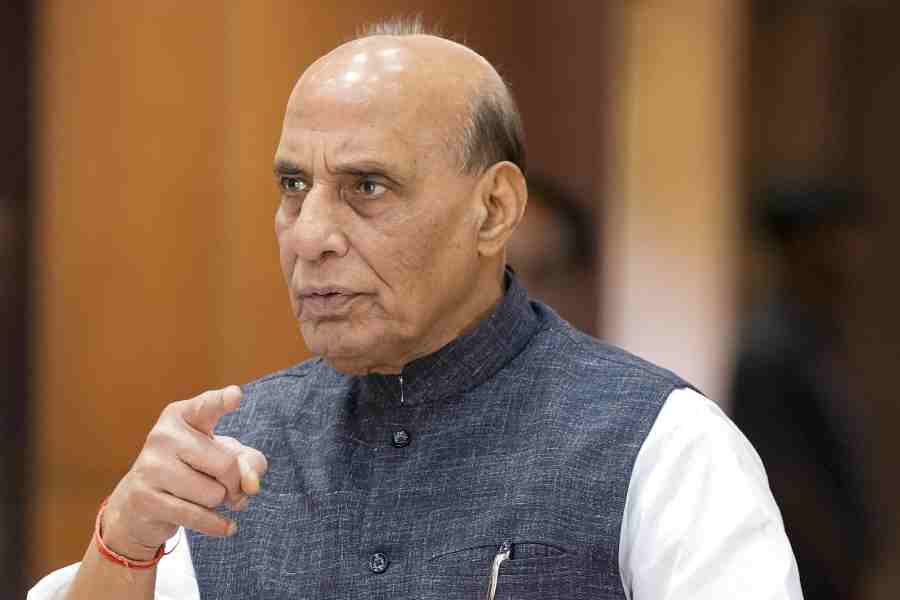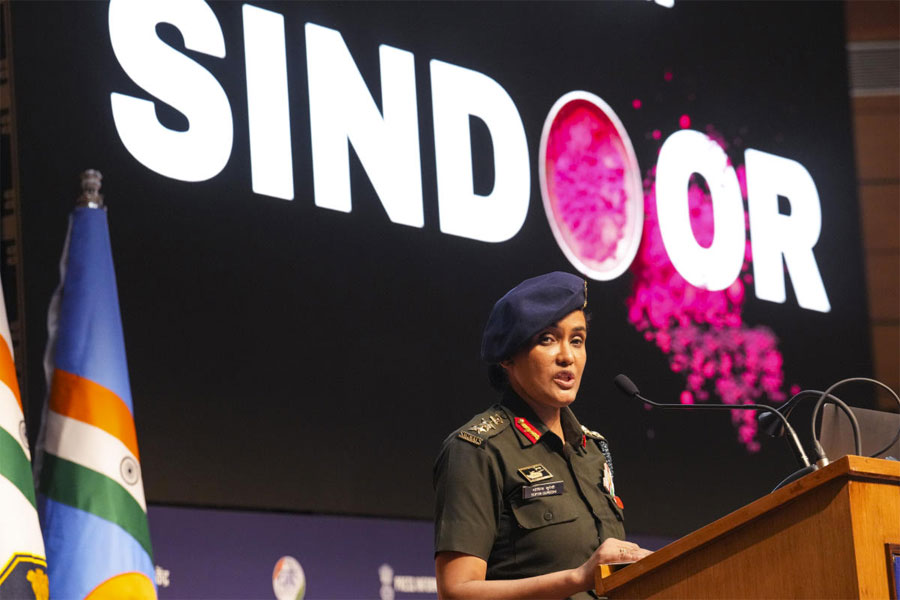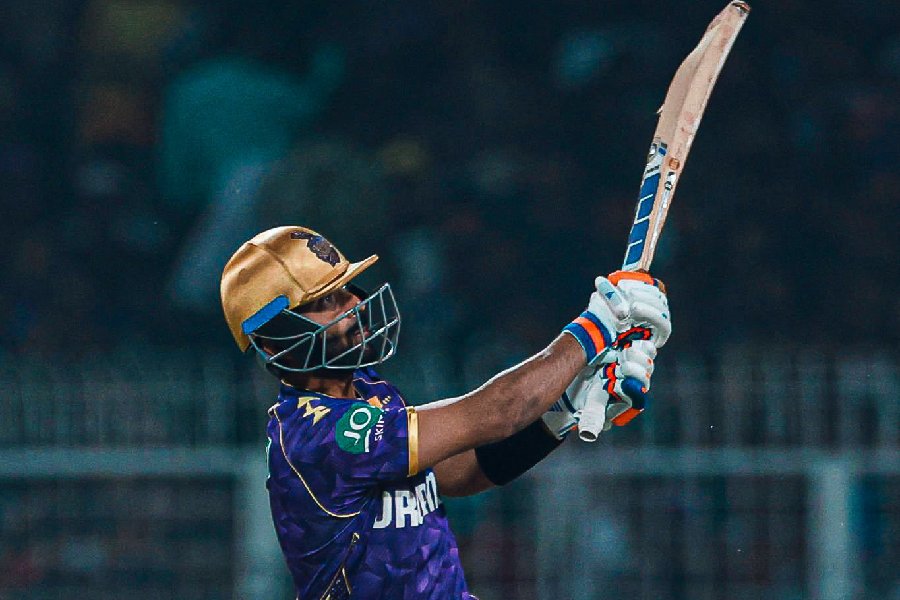-

FOOD FAVS: Smoke House Deli, Bangalore
Mukesh Ambani has heard the rooster call: he plans to start a restaurant chain named Chicken Came First. If the head of Reliance Industries does leap into the fast growing restaurant industry, he may end up burping all the way to the bank.
Ambani, of course, is the latest in a lengthening list of businessmen who're launching or have launched restaurant chains nationwide. They include men such as Venkatesh Iyer and Shiv Menon, who run 200 outlets of Goli Vada Pav; Sunil Kapur, who heads Pan India Food Solutions (which has 80 outlets, with brands such as Spaghetti Kitchen and Copper Chimney); Gaurav Goenka, whose Mirah Hospitality has 110 outlets of Rajdhani, Rasovara and other brands; and Calcutta's Anjan Chatterjee who owns Speciality Restaurants, which has 103 outlets of restaurants such as Mainland China and Oh! Calcutta.
Monish Gujral has 100 outlets of Moti Mahal and Jayaram Banan runs 98 branches of Sagar Ratna and Swagath. Amit Burman's Lite Bite Foods has 50 outlets of brands such as Scalini, Punjab Grill, FresCo and Zambar (see box).
Urban Indians are clearly working up a bon appétit. According to a food services report released by Delhi-based consultancy Technopak Advisors this year, the restaurant industry is the Indian economy's best kept secret. 'It's 10 times bigger than Bollywood,' exults restaurateur Riyaaz Amlani, secretary, National Restaurant Association of India.
The economy may be in the dumps, but the Rs 2,47,000-crore industry is booming. It is expected to grow at an annual clip of 11 per cent to touch sales of Rs 4,08,000 crore by 2018. Within this, the unorganised market holds a 70 per cent share. The organised market — comprising quick service restaurants, casual dining and fine dining, and licensed standalone restaurants — accounts for estimated sales of Rs 68,000 crore.
-

A thali at Rajdhani Rasovara, Mumbai
'The organised sector is slated to witness a double-digit growth of 16 per cent over the next five years,' says a Technopak spokesperson.
'The operating profit margins in the fine dining space range between 25 and 40 per cent,' notes Rupinder Singh, who started a restaurant consultancy in Mumbai, Wacky Restaurants. 'In the quick service category it is 15-25 per cent.'
Predictably, India's new El Dorado industry is drawing diverse players — from deep-pocketed companies to wannabe entrepreneurs.
Dabur scion Amit Burman forayed into the restaurant sector sensing a strategic growth opportunity. 'While lots of business houses entered retail, everyone was giving restaurants a miss. The industry had no player with a pan-India presence,' says Burman, who rolled out Lite Bite Foods in 2001 to plug the gap.
With a mix of franchised and in-house brands, Lite Bite posted a Rs 100-crore turnover last year, its outlets recording 2.5 million footfalls a year. 'We plan to scale up to 200 restaurants,' Burman says.
Look too at Jayaram Banan, whose life story reads like the script of a Bollywood potboiler. The son of a bus driver in a Karnataka town, Banan ran away to Mumbai to get away from his disciplinarian father. 'I worked as a serving boy and then manager in small town restaurants before moving to Delhi, where I turned entrepreneur,' he recalls. Banan opened a canteen-style idli-dosa outlet in Delhi's Defence Colony market in 1986. He called it Sagar.
The butter chicken-loving Delhi lapped up his southern fare. Apart from the Sagar Ratna chain, Banan runs Swagath for south Indian coastal cuisine. Launched in 2001, it now has 10 outlets. Some of Banan's restaurants are exclusively owned, some are partnerships and some franchisees. 'We plan to double our turnover and the numbers of restaurants in the next five years,' he says.
Like Banan, Amlani started small. He ran a shoe shop and worked as an entertainment consultant when his father gave him 500 sqft of space in his restaurant (Berry's in Churchgate, Mumbai). 'I set up a coffee caf�, Mocha. I had no money to do the interiors. I asked friends to donate furniture. We even have a watchman's stool as a seat,' Amlani laughs.
Although Mocha was no great culinary achievement, it did Rs 10-15 lakh worth of sales every month — giving Amlani the financial muscle to expand. 'We plan to add 20 restaurants in the next two years,' he says.
Amlani's Impresario Entertainment and Hospitality, Mumbai, runs 35 restaurants across eight cities. His brands include coffee shops Mocha and Mocha Mojo and diners Salt Water Grill, Smoke House Deli, delItalia and Le Kebabiere.
When Gaurav Goenka thought of taking over Rajdhani, he had no idea it would burgeon into a big chain. Rajdhani used to be a chaotic, canteen-style outlet in Mumbai's Crawford Market till 2005, when the brand was bought by Mirah Hospitality.
'The waiters had no uniform and there were no processes,' remembers Goenka, the company's young promoter. But Goenka knew he had a winner. The chain has served 8.7 million thalis in 23 cities, including Delhi, Calcutta, Bhopal and Chandigarh.
Goenka's stable of 110 restaurants offers everything from dhoklas to doughnuts. There's Falafel's for Lebanese food, Café Mangii for European, Ping Pong for dim sums, and the Manchester United Café Bar and Mad over Donuts chains. The company posted a turnover Rs 150 crore last year.
Industry experts believe that the chain restaurant segment is a gold mine waiting to be tapped. Licensed standalone restaurants — which comprise 22 per cent of the total market — form the largest chunk of the organised sector. But it is the chain segment — currently a puny five per cent — that's seeing bullish corporatisation, brand building and expansion.
'It's expected to increase its market share to eight per cent by 2018. The chain segment has high potential as most brands are in growth mode,' the Technopak consultant states. Some 100 brands in this segment operate an estimated 5,000 restaurants.
Industry experts believe India's eating-out market is sizzling because of rapid urbanisation, growing disposable incomes, increased participation of women in the workforce and changing diet patterns. The entry of foreign players too has impacted homegrown brands. 'They spruced up their menus, invested in marketing and upgraded standards in food, hygiene and service,' says Rajneesh Gandhi, CEO, Chefs at Work, a Bangalore-based restaurant consultancy.
But the real game changers have been the three Ps — the entry of private equity (PE) funds, people management and putting processes in place.
-

BOOMING BUSINESS: Rajdhani Rasovara, Mumbai
Venture capitalists have infused capital into an industry where real estate cost is the biggest deterrent to scaling up businesses. According to Venture Intelligence, a Chennai firm that tracks private equity funding in India, four deals worth $6 million were signed in 2009. In 2012, eight deals worth $104 million were inked.
Every eat-out idea — from vada pav to authentic Cantonese — is finding financial takers. In 2011, for instance, Sagar Ratna received Rs 180 crore in private equity funding, while Amlani's company received Rs 48 crore.
'This is a capital intensive business with a high return potential, which is getting PE firms interested,' says Tina Pawar, assistant vice-president, Everstone Capital Advisors, Mumbai. With an investment of Rs 200 crore through its platform Cuisine Asia, Everstone owns 80 per cent of Pan India Food, an 80-restaurant strong hospitality firm.
Restaurants scale up because expansion brings cost advantages. If a restaurant's processes are streamlined, it just follows the same systems on a larger scale. Raw materials are cheaper when bought in bulk. Some companies set up centralised kitchens to service multiple outlets, saving on labour and fuel costs.
'Cooking five kilos of dal makhani takes the same time as cooking 25 kilos. So fuel costs are reduced,' Gandhi says. Centralised kitchens also help restaurants maintain consistency in taste across outlets, he adds.
Cooking in such kitchens usually starts early morning. 'The staff works night shifts to prepare the food, which is cooked in the mornings.' Restaurants that serve lunches and dinners usually send in the food required for lunch by 10am. 'Dinner orders are placed after lunch hours,' Gandhi says.
But for every successful chain, several restaurants down their shutters. Mirah Hospitality closed six outlets of Rajdhani which it had set up in Tier-II towns. 'Burgers and pizzas are big sellers in small towns. People don't want to go to a restaurant and eat home food,' Goenka says.
Amlani had to close a fried doughnut outlet. 'It didn't go down well with calorie-conscious consumers,' he says. A Mocha outlet in Goa was shut because few wanted coffee on a beach. 'Especially when beer was cheaper than the coffee,' he adds.
The experts point out that anything — from location to parking to delayed service — can affect business.
'Real estate is always the biggest challenge in opening a new restaurant,' Burman says. 'While malls mushroom all over the place, not every new mall can attract the kind of quality footfalls that they intended to.'
Sagar Ratna shut a few restaurants because they were unviable, Jayaram Banan says. Higher costs which cannot be passed on to customers and high taxes are some reasons restaurants fail, he adds.
'The cost of ingredients and labour has increased. So margins are dropping and there is stiff competition,' Gandhi stresses. Then, of course, there is bureaucratic red tape to tackle. 'You need about 15 licences to start a restaurant,' Goenka says.
The industry's high attrition personnel rate (25 per cent, according to the Technopak study) is another problem. 'Being a low-automation industry, trained manpower is crucial for companies,' says Anjan Chatterjee.
With skilled workforce in short supply, companies are going all out to train and retain employees. Speciality runs an institute in Calcutta where 250 recruits are trained in restaurant management every year and absorbed in the company. All on-the-rolls employees are also required to go for annual training programmes.
'We believe training is at the core of this business,' says Chatterjee, who holds quality service as a big reason for his brands' success. Last year, Speciality became the first restaurant firm to go for an initial public offering (IPO) and reported a 14 per cent rise in revenue.
In the past, a major reason restaurants did not expand in numbers was the 'lack of processes', says the Technopak consultant. Now, the processes — an effective chain of suppliers, vendors, transporters and distributors and proper systems of storage, cooking, serving and delivering — are in place.
Speciality, for instance, signs annual price contracts with vendors to avoid the impact of market fluctuations. Lite Bite and Pan India Food have set up large-scale centralised cooking facilities.
Mirah's Mad Over Donuts chain follows a hub-and-spoke operating model. A mother kitchen supplies doughnuts to stores in the vicinity. 'The other stores can then be smaller spaces, saving on rent,' Goenka says. The Delhi-based Yo! China chain uses a cluster approach, focusing on one geographical area at a time to manage the outlets better.
Some of the chains are crossing borders too. Businesses see potential overseas because of the Indian diaspora, and an increasing global interest in Indian cuisine.
Saravana Bhavan, which serves south Indian vegetarian food, has 46 outlets in 12 countries. Speciality opened its Mainland China restaurant in Beijing and Bangladesh, though the Beijing outlet was closed because the Chinese government wanted the company to change its name. Rajdhani has an outlet in Oman; Sagar Ratna in Singapore. Lite Bite Foods has opened Punjab Grill in Singapore and is looking at Bangkok and Abu Dhabi. Indian coffee chain Café Coffee Day is present in Vienna, Prague and Karachi.
'Going global brings in higher revenues and also builds the brand image,' Goenka says. But it's not easy, he points out. 'Finding the right franchisee can be difficult.'
Many of the chains have also spread to smaller towns. Chatterjee is finalising plans to take Mainland China to Tier-II towns — a first for a fine-dine chain in India. 'Streamlined processes make expansion profitable. The economies of scale kick in after the tenth unit,' he holds.
In the world of food, entrepreneurs are clearly licking their chops, while customers whet their appetites. Everyone, indeed, is asking for more.
India's restaurant barons
1. Venkatesh Iyer and Shiv Menon, Goli Vada Pav - 200 outlets
Brand: Goli Vada Pav
2. Gaurav Goenka, promoter & managing director, Mirah Hospitality - 110 outlets
Brands: Rajdhani, Rasovara, Falafel's, Mad Over Donuts, Café Mangii, Manchester United Café Bar, Ping Pong
3. Anjan Chatterjee, Speciality Restaurants - 103 outlets
Brands: Mainland China, Oh! Calcutta, Flame and Grill, Machaan, Sigree, Haka, Just Biryani and Sweet Bengal
4. Monish Gujral, promoter, Moti Mahal Group - 100 outlets
Brand: Moti Mahal
5. Jayram Banan - 98 outlets
Brand: Sagar Ratna and Swagath
6. Sunil Kapur - 80 outlets
Brands: Spaghetti Kitchen, Copper Chimney, The Cofee Bean & Tea Leaf, Bombay Blue, Noodle Bar, Gelato Italiano
7. Amit Chadha, co-owner, Nirula's Corner House - 58 outlets
Brand: Nirula's
8. Amit Burman, Lite Bite Foods - 50 outlets
Brands: Scalini, Punjab Grill, FresCo, Asia7, Zambar, Street Foods of India, Rapps, Pino's Pasta Pizza, Baker Street, Big Gulp, Pollo Compero
9. Ashish Kapur, promoter, Moods Hospitality - 48 outlets
Brand: Yo! China
10. Dheeraj Gupta, Jumbo King Foods - 38 outlets
Brand: Jumbo King
11. Sajid Dhanani, managing director, Sayaji Hotels - 35 outlets
Brand: Barbeque Nation
12. Vithal Kamat, 35 outlets
Brands: Vithal Kamats. (The company also owns Ecotel, Orchid hotels.)
13. Manish Aggarwal, director-owner, Bikanervala Foods - 33 outlets
Brand: Bikanervala
14. P. Rajagopal, Saravana Bhavan Group of Hotels - 32 outlets
Brand: Saravana Bhavan
15. Riyaaz Amlani, Impresario Entertainment & Hospitality - 31 outlets
Brands: Mocha, Smoke House Deli, Salt Water Grill, Stone Water Grill, The Tasting Room, Le Kebabiere, delItalia
Excludes Domino's Pizza, 552 outlets; Subway, 344 outlets; McDonald's, 311 outlets; KFC, 227 outlets; US Pizza, 100 outlets; Pizza Corner, 63 outlets.
Source: Technopak Advisor's India Food Services Report (2013)











